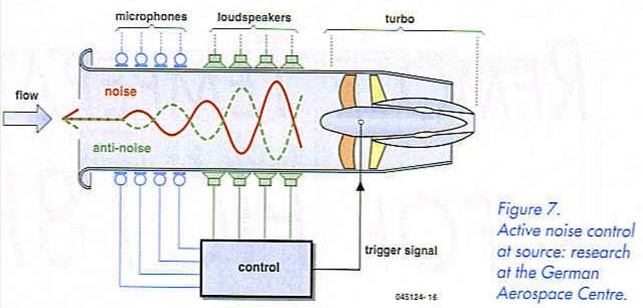

Project Solutions
ANTI-NOISE (2)
Published:2011/8/17 22:36:00 Author:Phyllis From:SeekIC
If passive ear protectors, such as earplugs or closed headphones, are combined with active noise compensation, noise in the frequency range from 25 Hz to 500 Hz can be attenuated by more than 25 dB (Figure 5). The total effect of active and passive noise compensation is around 30 dB over the entire audio spectrum. Closed systems are particularly suitable for aircraft with a high noise level in the cockpit, such as helicopters and military aircraft, as well as for most propeller aircraft. These closed systems can be retrofitted with ANR kits to add active noise compensation. The picture at the beginning of the article shows a headset together with an ANR module from an ANR kit. As can be seen from the photograph, each module consists of two headphone loudspeakers with an electret microphone capsule positioned between the two loudspeakers. On the rear side of the module is a printed circuit board carrying SMD components. On closer inspection, the two ICs reveal themselves to be a TL064C (quad FET opamp) and an MC34119 (low power audio amplifier). Superficially the circuit looks like a relatively simple analogue ANR circuit, but tests and experience show that it is highly effective. Kits of this type are available from outlets dealing in aircraft equipment. The modules and headset pictured are available from Biischer-Flugversand, 43466 Wolfhagen, Germany (WWW.flugversand.de, website in German only). 
Active noise control
In the applications of noise compensation that we have described the spatial volume over which noise is reduced is narrowly limited. Under these conditions ANC is at its most effective. In larger spaces and in the open air it is much harder to achieve noise compensation. There has, however, been some progress in this direction. In aviation, noise compensation has been used in the cockpit since the mid-90’s, especially in turboprop aircraft and, more recently, in a business jet. The first commercial aircraft to be fitted with such a system is the Swedish Saab 2000. The system, by Ultra Electronics Ltd. (www.ultraquiet.COITl), uses 71 microphones in the cabin to continuously analyze the noise spectrum. A powerful microprocessor system processes the signals and generates a phase-shifted correction signal that is emitted though 36 loudspeakers. ANC is particularly useful for reducing propeller noise. A similar application area is reducing the noise produced by large ventilation fans in climate control equipment. Industrial motors can also be equipped with ANC. In the automotive sector ANC is still at the research stage, but it would of course be interesting to be able to exploit the existing loudspeaker arrangements. 
It would make more sense to try actively to reduce the noise at the point of production rather than at the receiver. This is an area of current research, but the practical results have so far been few. Figure 7 shows the construction of a research project at the German Aerospace Centre aimed at reducing the noise from an aircraft engine turbine. Experts calculate that a reduction of between 10 do and 20 dB in noise level can be achieved. This corresponds to between one half and one quarter of the original volume. 
The ANC anti-noise technique can be applied not only to noise, but also to vibration. The techniques of AVC (active vibration control) and ASAC (active structure acoustic control), which aims to reduce noise produced as a result of vibration, look to have a bright future.
Reprinted Url Of This Article: http://www.seekic.com/blog/project_solutions/2011/08/17/ANTI_NOISE__(2).html
Print this Page | Comments | Reading(1933)
Article Categories
New published articles
· Imagination works with TSMC to develop FinFET process
Author:Ecco Reading(45431)
· XMOS pushes event-driven MCUs with lower price
Author:Ecco Reading(4140)
· Intel brings upgraded 32-nm SoC for smartphones
Author:Ecco Reading(3863)
· Micron pushes TLC 128-Gbit NAND flash
Author:Ecco Reading(4611)
· Intel will stop supplying desktop motherboards
Author:Ecco Reading(5961)
· Processor market was expected to regain strength in 2013
Author:Ecco Reading(3956)
· It was reported that TSMC sales fall steeply
Author:Ecco Reading(3618)
· Cisco, NXP work with auto wireless startup
Author:Ecco Reading(4282)
· Micron was impacted by manufacturing glitch
Author:Ecco Reading(4647)
· China can make 22-nm transistor by themselves
Author:Ecco Reading(4485)
· Chip market rebound is coming, according to survey
Author:Ecco Reading(4386)
· Sony, Toshiba will spend more on chips, iSuppli reports
Author:Ecco Reading(3953)
· Qualcomm becomes the 13th company to join NFC Forum board
Author:Ecco Reading(6795)
· TSMC increases building work for FinFET fab
Author:Ecco Reading(4467)
· TI plans to cut 1,700 jobs in OMAP shift
Author:Ecco Reading(5327)